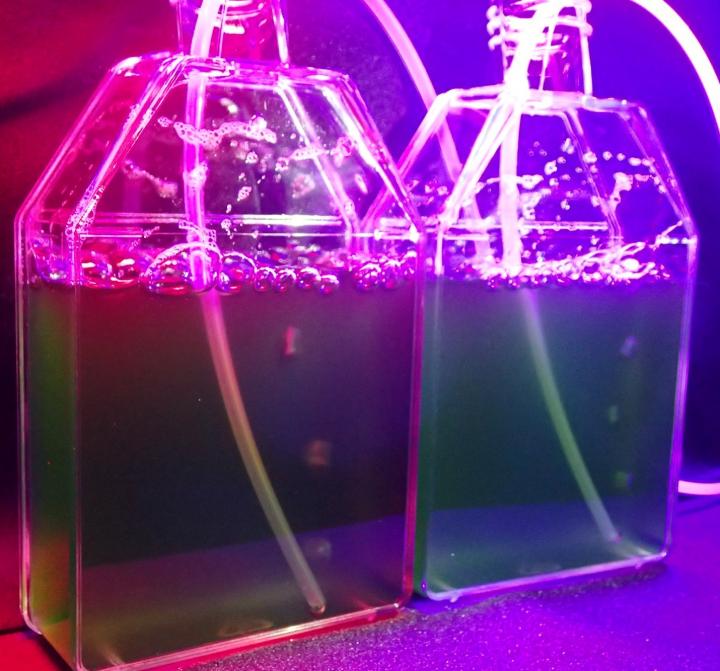
Red and violet light reset the circadian clock in algae via novel pathway

C. reinhardtii algae is illuminated with red (left) and violet (right) light, which resets their circadian clocks via a novel pathway.
Credit: Ayumi Kinoshita
As anyone who has spent wakeful nights suffering from jetlag will attest, the human body has a strong sense of time. The body clock runs on a 24-hour cycle, or circadian (from the Latin meaning “about a day”) rhythm. When our internal cycle gets out of sync with our surroundings, such as when crossing time zones, jetlag can result. The circadian rhythm therefore needs to be reset, which is achieved primarily by exposure to light.
However, such timekeeping prowess is not exclusively ours. A wide range of organisms benefit from the ability to sense and synchronize with their environments. For a photosynthetic organism–one that uses light as an energy source–such as the green alga Chlamydomonas reinhardtii, keeping in sync with day and night is a particularly important ability. C. reinhardtii is a popular tool among researchers seeking to unpack how organisms sense and respond to light.
A Nagoya University-led team has now uncovered a pathway in C. reinhardtii that allows it to reset its circadian clock when exposed to light. The researchers used C. reinhardtii that had been genetically altered to add a luminescent label to ROC15, a protein they previously showed is involved in circadian timekeeping. ROC15 levels are usually high overnight, then drop rapidly at dawn and remain low during daytime. Using this system, the team then screened over 10,000 different genetically mutated C. reinhardtii to identify genetic changes that disrupted the daily rhythm of ROC15.
“We identified several mutants in which the ROC15 daily response to light was impaired irrespective of the color of the light,” says Ayumi Kinoshita lead author of the article reporting the results. “However, we were particularly intrigued to discover one mutant had a normal response to blue light, but a defective response to red or violet light–both the expected drop in ROC15 levels and the overall resetting of the circadian clock were impaired. This tells us there are at least two different pathways in C. reinhardtii that allow it to sense and respond to different colors of light.”
Further investigation of this pathway revealed the gene whose mutation caused the defect. The researchers named the gene CSL. Restoring normal CSL in the mutant algae fixed the defective response of the circadian clock to red and violet light. However, the precise nature of the protein produced by the gene remains something of a mystery.
“We discovered that CSL produces a protein similar to one involved in a major cellular signaling pathway in other organisms, including plants and animals” corresponding author Takuya Matsuo says. “The next challenge is to unravel exactly how it is involved in allowing C. reinhardtii to reset its circadian clock when exposed to red or violet light.”
###
The article, “CSL encodes a leucine-rich-repeat protein implicated in red/violet light signaling to the circadian clock in Chlamydomonas” was published in PLOS Genetics at DOI: 10.1371/journal.pgen.1006645.












